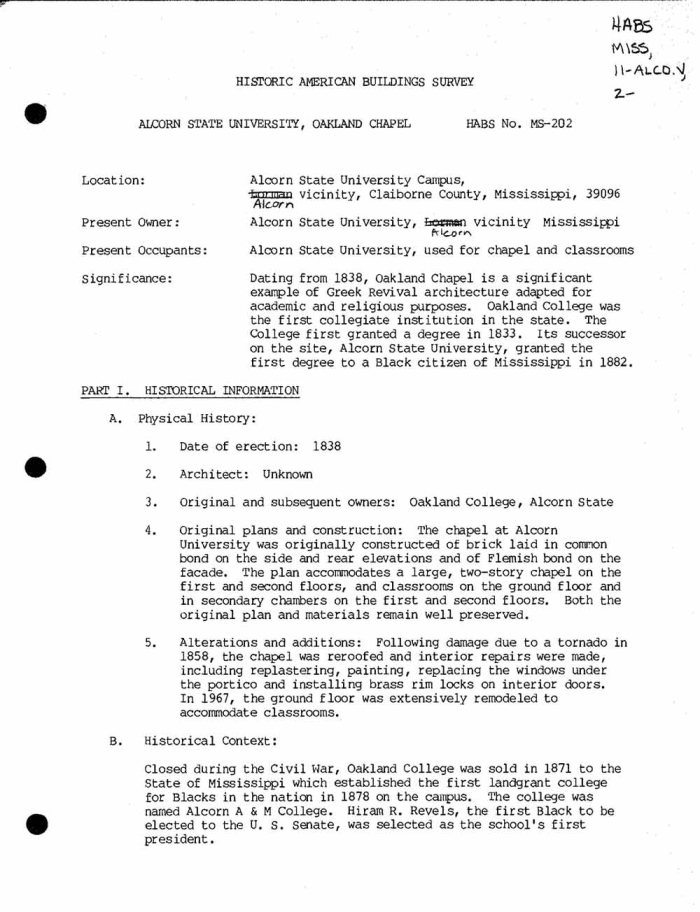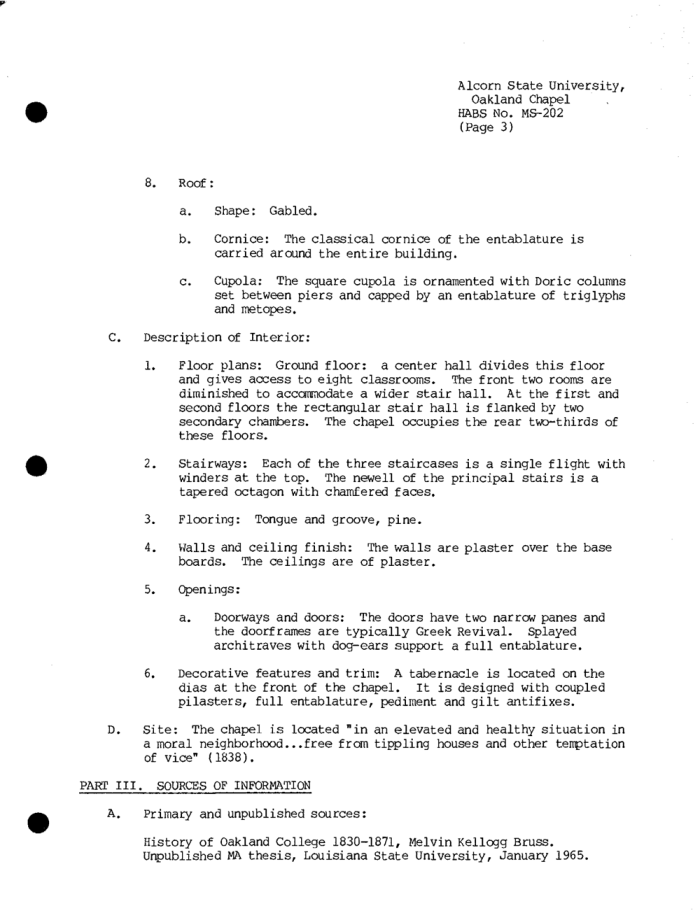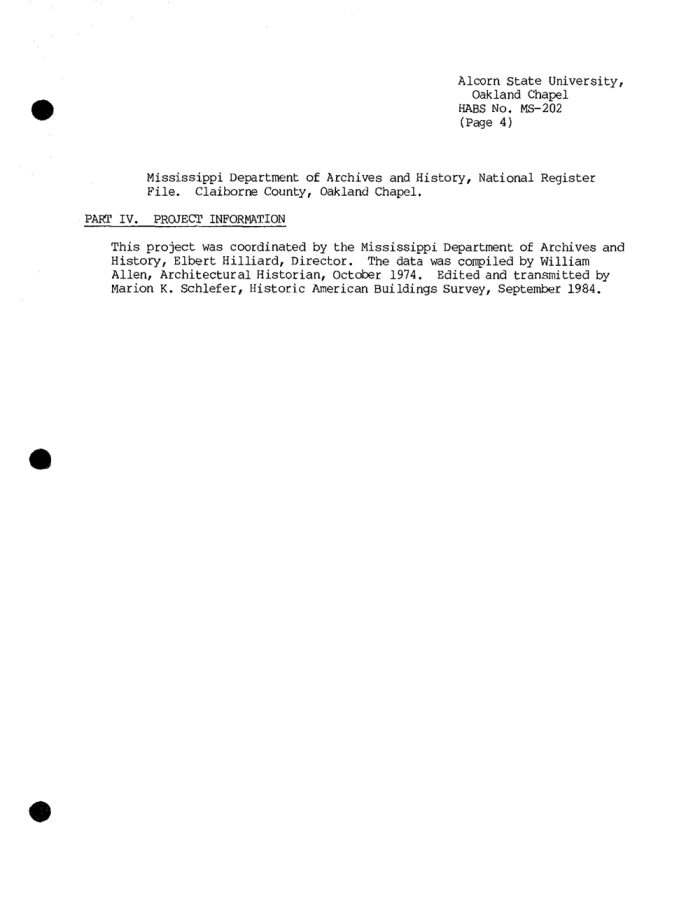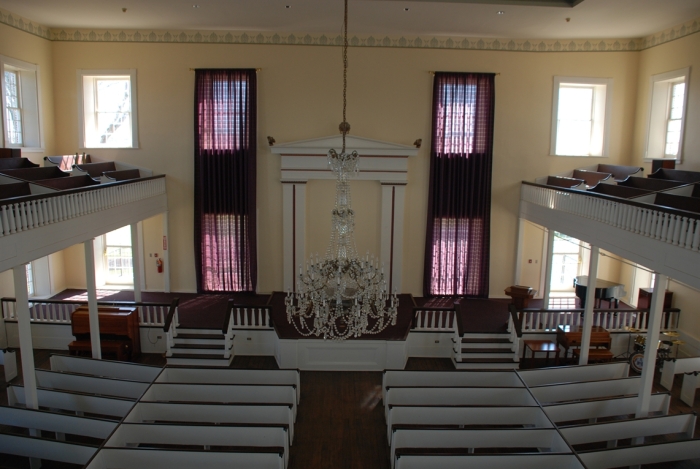Strangely enough for a National Historic Landmark (and one of the 101 Mississippi Places To See Before You Die), we really don’t appear to have great information about the construction of Oakland Chapel at Alcorn State University. Originally built as the chapel for Oakland College, a Presbyterian school, the building later became the centerpiece of the nation’s first land-grant college for African Americans when Alcorn College opened in 1871. While the HABS information from 1972 below gives a construction date of 1837, the Mississippi Historic Resources Database gives a date of 1840-51, a range probably taken from Ed Polk Douglas’s Architecture in Claiborne County: A Selective Guide (1974, p. 81). The MDAH database goes on to give yet another start date, apparently derived from the National Historic Landmark nomination:
Begun in 1838 as the main building of Oakland College, it is now the oldest building of Alcorn State University, the first land-grant college for African Americans in the nation. A temple-form Greek Revival brick auditorium with a two-story-high interior space, on a high brick basement, with a hexastyle portico. The iron steps leading to the portico were formerly the front steps of “Windsor” (021-ALC-1001).
Surely the names of the architect and builders of such an imposing building were recorded somewhere for us to find 170 years later?
It’s disappointing that HABS took no interior photos in this 1972 photo shoot. This is one building I’ve never been inside of, so I’ll have to make do with the photos MDAH took in 2013, which you can find here or by clicking on the image below.
Read more . . .
- Historic American Buildings Survey
- MDAH Historic Resources Database
- National Historic Landmark nomination
Categories: Antebellum, Architectural Research, Cool Old Places, Historic American Building Survey (HABS), Universities/Colleges
















There is no information about Oakland Chapel’s construction in the school history Centennial History of Alcorn A. &. M. College by Melerson Guy Dunham, though the book does say that the college buildings were constructed by area slaves whose descendants have likely attended Alcorn. However, one of the footnotes states that an early secondary source for Oakland’s history is Benjamin Chase’s Brief Sketch of the Origin and History of Oakland College, an unpublished 1867 manuscript held by the Natchez Historical Society. It is possible that manuscript has some information about the Chapel that has not been passed down into later texts.
Of course, since we do not know the architect of the related Bethel Presbyterian Church, likely the same individual that designed Oakland Chapel, it is quite possible that we will never know Oakland’s architect/builder.
LikeLike
Oakland chapel was constructed in stages, beginning with Oakland founder Jeremiah Chamberlain’s “felling of the first tree” in 1830, for the construction of thirteen temporary cottages. These were followed by the President’s House in 1834, portions of which still remain as the oldest structure on campus. In 1838 the foundation was laid for the building now known as Oakland Chapel. It consisted of one floor of rooms about which Chamberlain reported to Governor McNutt in 1840 “to be finished three stories high as soon as funds will warrant it.” The upper floors exhibit a more sophisticated detailing and somewhat later construction. President Jeremiah Chamberlain was assassinated in 1851. The building is thought to have been completed two years later.
The above information can be found in a Historic Structures Report by architect Robert Parker Adams, who was architect for the 1996 restoration.
LikeLiked by 2 people
I would love to read that report. You would not happen to have a copy that you could scan and send to me, would you?
LikeLike
I was interested to see an ‘old friend’ in the form of the Alcorn U/Oakland College chapel in this post. My first visit to the campus was in the mid-1950s, and, then, I got to know it better when I spent a month in Claiborne County in the summer of 1972 gathering data that eventually became ARCHITECTURE IN CLAIBORNE COUNTY, MISSISSIPPI(Jackson, 1974).
You were kind to mention that work– the first county-wide architectural survey in Mississippi– and, since next summer is the 45th anniversary of my time there, perhaps, by then, I will have some reminiscences composed for your readers.
In any case, the chapel continues to interest me, and, for the past year, i have been on the trail of data that might shed light on some of the building’s mysteries. It was good to have the material from W.White and Bob Adams above, too, and I hope other knowledgeable readers will similarly respond.
Along with the big questions about the building, there are little things that have concerned me. I have always wondered if any of the structure was usable before the building was completed–perhaps the ground floor? Of course, it must have been depressing for the administration, faculty, trustees, students, local folks, visitors, etc. that it wasn’t finished until the early 1850s–an awfully big structure, in a prominent location, surrounded by scaffolding for so long!
And, how did the building look prior to the post-1890 ‘addition’ of the cast-iron staircase from fire-destroyed ‘Windsor’? Was there a central stair, in the place that the current stair occupies, or, perhaps, might there have been one or two smaller staircases within the porch? Presumably, previous steps were of wood, so the ‘Windsor” stair was less maintenance–and, more decorative.
The frontal square steeple is certainly a distinctive feature, and, rather more sophisticated that the form of the other elements. Was this because it wasn’t constructed until ‘the end’ or was it originally meant to ‘stand out’? One wishes that the later disfiguring elements could be eliminated.
And, for this and the other older buildings on campus, doesn’t someone have ‘archival photos’?
Maybe these are in the same ‘cache’ that also contains the pre-fire ‘Windsor’ views, huh?
LikeLiked by 3 people
I’ve been pondering the idea that the Weldon Bros, who had a sawmill just up the road in Rodney by the late 1840s, might have been responsible for finishing the chapel. Even if it isn’t true, I like to think about it. But it makes a lot of sense to me.
LikeLike
speaking of the alcorn campus, would love to know the status of any of the other buildings there which i included in my claiborne county volume— belle letres(p. 80); former pres’s house(p.84), dorms(p.81); what about the old cemetary ? it was so overgrown in 1972 that i couldn’t make photos! and, the board-and-batten gothic revival cottage adjoining the campus, then owned by alcorn(p.79)?; from some images i found recently on the internet, ii noted that the current president’s house is a version of ‘monteigne’, natchez– or, the 1926 remodelling of the earlier house(a popular model to copy for a long time!)
LikeLike
You can see fairly recent pictures of many of the buildings on the campus, and the cemetery, from the 2011/2012 survey MDAH did. http://www.apps.mdah.ms.gov/Public/rpt.aspx?rpt=publicPropSearch&Name=alcorn%20state&StreetNo=&StreetName=&City=Any&County=Any
Belles Lettres Hall was renovated in 2011 under the direction of Bob Adams. Looked great when we were photographing it!
In general, I thought the campus was in good shape and full of life.
LikeLike
quick note– yes, weldon bros sound like a good guess. they did the claiborne county courthouse….and, yes, thanks for the links to look at current status of alcorn bldgs—-
LikeLike
through the ‘wonders’ of the internet, i have just ‘discovered’ the post- 1871 image(print) of the alcorn campus presumably created soon after the state purchased the property from the trustees of oakland collge–it is in the mdah online timeline for 1871. i have never seen this, so, it’s kind of a revelation, since it shows so many of the earlier buildings; it is titled, “alcorn a & m college, rodney”.
(i wonder if our webmaster might be able to post this? i feel others would be interested; and, where is the image from? no credit line on the mdah site. is it from a printed history of either oakland or alcorn?)
(also, since i don’t have my [now- ancient] claiborne county notes handy, is there a chance of a campus map that could be posted with this image– to show the buildings ‘in context’?)
the chapel is in the center—AND FOLKS, THERE IS THE PRE-WINDSOR STAIRCASE!!!!!!!!!!!!!!!!!!!!!!! a double stair, rising parallel to the facade to the center of the portico– and, no doubt, wooden. there is the ‘top’ of the tower, with a parapet(which we knew was once there), but, the doric columns within the antae seem to be missing.
to the left of the chapel, there are three porticoed structures– i am guessing that the one at the far left is one of the literary societies, might the other two be the dormitories; to the right of the chapel, there is a small two story structure–seems almost connected to right rear of the chapel–and, another of the dormitories, and, at the far right, is that the other literary society building(?). where is the fourth dormitory?
(speaking of the surviving literary society building, i have today also found images of its pre- and post- restoration exterior condition; obviously, the pitch of the roof, along with the pediment’s details, have been changed as well as the entablature–and, these changes ‘early up’ the structure considerably. what is the story, if any one knows? are the changes based on sound research? guess this would be due to bob adams?)
since we presume that there was no construction on the campus after 1861, might the existence of the two literary society buildings in this print indicate that they were ‘pre-1861’ even though their details look 1870s— or, might the print be later than 1871(when alcorn was founded) and the literary society structures constructed for alcorn soon after the college was founded? or, ‘pre-1861’, remodeled later? if the current rendition of the portico is supposed to be ‘pre-1861’, what about the rather italianate windows(although
“windsor”, according to the 1863 sketch, seems to have had a mix of grecian and italianate details).
after finding this alcorn image today, i am all set to find a pre-fire image of ‘windsor’, so let me get back to the net! and, i’d also better go out and buy a lottery ticket!
LikeLike
Can you paste the link to the photograph into a comment? Sometimes WordPress will then show the picture right here so we can see it without having to click over to the other website.
LikeLike
The image he is referring to is from the 1893 book “A History of Mississippi for Use in Schools” by Robert Lowry and William H. McCardle, at least according to MDAH’s catalog record for the image. The book can be read in the archival reading room at the MDAH.
LikeLiked by 1 person
You heard it here first, folks, Ed Polk Douglas is volunteering to share his winning lottery ticket with the MissPres universe!
LikeLike
We are missing a photograph of Windsor, though we do have a drawing of Windsor by Lt. Henry Otis Dwight that is in the collections of the Ohio Historical Society. The 1863 drawing is the only known eyewitness depiction of Windsor. It languished in the OHS collections for decades before being published in “Lost Mansions of Mississippi.” We still need either a better quality drawing (Lt. Dwight’s drawing is just a sketch) or a photograph.
LikeLike
Here is the sketch, for reference.

LikeLike
first of all, thank you, w.white, for the comment on the ‘windsor’ sketch; i am quite familiar with it, from its first discovery, and i have published thoughts on it in other media over the years.. one important thing to remember, which you do point out, is that it’s a sketch. dwight was an amateur artist, at best; and, he probably did the drawing from memory, although possibly ‘recent memory’. there are a number of things that don’t conform to the facts; but, yes, it is all we have at present.
many years ago, i predicted that a photograph exists ‘somewhere’, but the house is in the background and is not recognized. with the advent of all the images on the net in recent years, yes, i have hoped to find such a view—frequently, i search under various subjects, even those that might seem silly, but, no luck yet!
re the alcorn print, sadly, i am not computer saavy enough to transfer the print to this site, but, i will see what i can do otherwise. oh, and, as everyone will see, if we can post it, underneath the view(which is titled, “alcorn a & m college, rodney”) there is another caption, “oakland college from 1830 to 1871”.
and, since my copy of AICCM was not handy here at our local library last night when i wrote about my ‘discovery’, i made a mistake in the number of ‘dormitory’ structures originally at oakland; my text states that there were three, and, so, all three of them appear in the print. and, further, might the small structure to the right rear of the chapel be a dining hall?
LikeLike
I am not familiar with your other comments about the drawing. I would like to know some of your opinions on it.
I know that the first thing I noticed about the drawing was the rear wing. I know that Windsor had the rear wing/ell, but seeing it in the drawing, from that angle, just looks rather strange. The cupola and angle of the roof look off as well, but if the roof line was just somewhat shallower, it would be similar to Waverley’s. Compared to some other Mississippi plantation houses, it would not be much of a stretch for Windsor to have such a large cupola, especially with Smith Daniell’s desire to build bigger than anyone else. Also, I always assumed that the bay of windows on the farthest left in the drawing are an error, since that would be the front entrance portico.
LikeLike
i know i am not alone in suffering from ‘windsor-itis’–i got the ‘bug’ back in the 1950s!– but by continuing our discussion of that place on this ‘conversatoin’, we are getting away from our original oakland college/alcorn state u topic(s).
might i suggest that our webmaster post the dwight sketch of ‘windsor’ as another ‘conversation’ on misspreservation.com, and, then, those that are interested might comment there.
i still have alot of ‘unresolved issues’ about the original oakland college buildings, and, in the near future, i’ll restate my previous, unanswered questions and ask others(on this ‘conversation’)
as a p.s, i would also enjoy separate conversations about bethel presbyterian chuch, claiborne county, and the weldon brothers, among other topics.
LikeLike